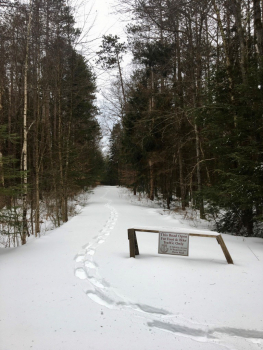You are here
A New Forest Home

Julian was a winter intern at the Harvard Forest in January 2019.
Though I grew up right outside the Catskill Park, it took leaving home to realize how important forests were to me. After a few years lived at the hectic pace of Harvard, only escaping Cambridge’s brick enclosures for vacations and summer internships, I gained a newfound respect for the quiet patience of my childhood home in Halcott, New York. No matter where I went, I was always pulled back to those forests, my soul tethered to the white ash and sugar maple. Towards the frantic end of this last semester, my father sent me a photo he took from our barn window of the first frost blanketing the bare trees at the top of Bear Pen Mountain. I must have showed that photo to everyone I encountered those last few weeks, hoping that they would understand something about me from seeing the land I came from.
I share this anecdote to provide some context on how I ended up at the Harvard Forest. My interest in forest conservation is somewhat different from the passion of my friends who study subjects like ecology, though I feel blessed whenever they share their meticulously-gathered knowledge about nature’s intricate patterns. I celebrate science and those who dedicate their lives to it, because they are the diagnosticians of our planet’s ailments and the archivists of its elegant structures. Still, as a chronic humanist, my feet planted solidly in history, literature, and anthropology, I believe there is another dimension of environmental change that must be elaborated interpretively, in conversation with but distinct from empirical observation.
For me this dimension is the intuitive sense, buried under millennia of evolution and civilization, that the forest is home. I do not presume to speak for anyone else, because I do not believe my experience is universal, and that is essentially the point. My commitment to conservation comes from a conviction that our relationships with land, though reducible to simple narratives of historical and biological inevitability, are deeply individual. We are always telling different stories about the land and our place on it.
It was this instinct that told me to apply for a Harvard Forest winternship to develop an interactive StoryMap of university land conservation in New England. Aside from providing the opportunity to work alongside a fantastic team of people with deep passions and big hearts, my time at the Harvard Forest let me contribute a few pages to the story of how Americans have treated our land. Though the universities we profiled had similar commitments to conservation, each expressed their commitment through different structures and programs. I hope that the final StoryMap will stand as an example that there is no right way for academic institutions to contribute to land conservation; there are many right ways.
My brief stay in Petersham gave me the chance to start contributing to another project spearheaded by the Harvard Forest: the story of the eastern hemlock. Last semester I wrote an environmental history paper on the hemlock tanning industry in New York State, which led me to read the book Hemlock: A Forest Giant on the Edge edited by Harvard Forest Director David Foster. With the encouragement of my professor, I have decided to use my last semester at Harvard for an independent study in which I will put the history of the hemlock’s 19th century deforestation by lumber and tanning interests in conversation with the unfolding social drama of its current deforestation by the hemlock woolly adelgid. While in Petersham, I got the chance to discuss this project with Dr. Foster, who provided many valuable insights about the tree’s shifting place in our collective environmental imagination.
It is my hope that I will carry my time at the Harvard Forest with me as a reminder that telling the stories of land is an exercise suited to everyone, regardless of background or experience. I believe that is the only way we will ever come close to knowing the full story.

